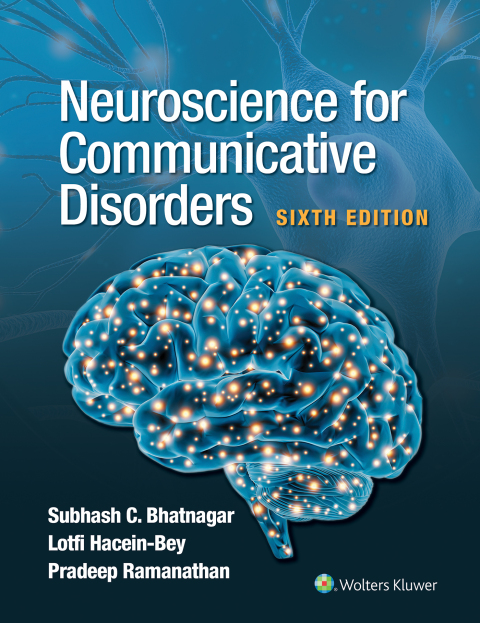Description
Efnisyfirlit
- Cover
- Half Title
- Title
- Copyright
- Dedication
- Foreword
- Preface
- Acknowledgments
- Contents
- 1 Orientation to Essential Neurological Concepts
- Neuroscience and Speech-Language-Hearing Pathology
- Orientation to Neuroscience
- Orientation to Principles of Brain Functioning
- Orientation to Neurological Terminology
- Orientation to Neurological Concepts
- Orientation to Techniques for Learning Neuroscience
- Orientation to Critical Thinking
- Clinical Correlates
- Summary
- Review Questions
- 2 Gross Anatomy of the Central Nervous System
- Central and Peripheral Nervous Systems
- Divisions of the Embryonic Brain
- Anatomy of the Brain
- Diencephalon
- Brainstem
- Cerebellum
- Spinal Cord
- Ventricles
- Cortical White Matter
- Meninges of the Brain
- Meninges of the Spinal Cord
- Peripheral Nervous System Basics
- Autonomic Nervous System
- Clinical Correlates
- Summary
- Review Questions
- 3 Internal Anatomy of the Central Nervous System
- Anatomical Landmarks
- Spinal Cord in Cross Sections
- Brainstem in Transverse Sections
- Orientation to the Forebrain Anatomy
- Forebrain in Horizontal Sections
- Summary
- Review Questions
- 4 Development of the Nervous System
- Human Chromosomes, Genes, and Cell Division
- Early Human Development
- The Central Nervous System
- The Peripheral Nervous System
- Genetic Inheritance
- Clinical Correlates
- Summary
- Review Questions
- 5 Nerve Cell Physiology
- Neuron
- Central and Peripheral Nervous Systems’ Differences
- Nerve Impulse (Action Potential)
- Neuronal Responses to Brain Injuries
- Synapse Development and Neuroplasticity
- Neurotransmitters
- Drug-Related Concepts
- Clinical Correlates
- Summary
- Review Questions
- 6 Diencephalon: Thalamus and Associated Structures
- Anatomy of the Diencephalon
- Thalamus
- Epithalamus
- Subthalamus
- Hypothalamus
- Cognitive Functions of the Thalamus
- Clinical Correlates
- Summary
- Review Questions
- 7 Cerebrovascular System
- Brain’s Dependence on Oxygen
- Vascular Network
- Ischemia Risk Factors
- Venous Sinus System
- Regulation of Cerebral Blood Flow
- Clinical Correlates
- Summary
- Review Questions
- 8 Ventricles and Cerebrospinal Fluid
- Choroid Plexus
- Cerebrospinal Fluid Circulation
- Absorption of the Cerebrospinal Fluid
- Clinical Correlates
- Summary
- Review Questions
- 9 Auditory System
- Anatomy and Physiology
- Central Auditory Pathways
- Auditory Reflexes
- Vascular Supply to the Auditory Mechanism
- Distinctive Properties of the Auditory System
- Clinical Correlates
- Summary
- Review Questions
- 10 Vestibular System
- Vestibular System Anatomy
- Controlling Eye Movements
- Physiology of Equilibrium
- Clinical Correlates
- Summary
- Review Questions
- 11 Somatosensory System
- Somatosensation
- Sensory Pathways for the Head and Face
- Unconscious Proprioception
- Clinical Correlates
- Summary
- Review Questions
- 12 Visual System
- Three Clinical Terms of Interest
- Eyeball Anatomy and Functions
- Vascular Supply of the Retina
- Central Visual Pathways
- Visual Reflexes
- Clinical Correlates
- Summary
- Review Questions
- 13 Motor System 1: Spinal Cord
- Hierarchy of Motor Function
- Spinal Preparation
- Innervation Pattern
- Anatomical Markings
- Tracts of the Spinal Cord
- Motor Nuclei of the Spinal Cord
- Motor Functions of the Spinal Cord
- Spinal Reflexes
- Neurotransmitters
- Clinical Correlates
- Summary
- Review Questions
- 14 Motor System 2: Cerebellum
- Cerebellar Role in Movement
- Cerebellar Anatomy
- Innervation Pattern
- Cerebellar Cortex
- Motor Learning
- Nonmotor Cerebellar Functions
- Clinical Correlates
- Assessment
- Summary
- Review Questions
- 15 Motor System 3: Basal Ganglia
- Basal Ganglia Motor Functions
- Basal Ganglia Anatomy
- Clinical Correlates
- Summary
- Review Questions
- 16 Motor System 4: Motor Cortex
- Anatomy of the Motor Cortex
- Cortical Functional Organization
- Terms of Clinical Importance
- Pathways
- Clinical Correlates
- Summary
- Review Questions
- 17 Synopsis of Cranial Nerves
- Evolutionary Base of Cranial Nerves
- Functional Classification of Cranial Nerves
- Pharyngeal Origin of Speech Muscles
- Autonomic Functions of Cranial Nerves
- Cranial Nerve Nuclei
- Sensorimotor Pathways for Cranial Nerves
- Bilateral-Unilateral Control of Cranial Nerves
- Functions of Cranial Nerves
- Functional Combinations of Cranial Nerves
- Clinical Correlates
- Summary
- Review Questions
- 18 Axial-Limbic Brain: Autonomic Nervous System, Limbic System, Hypothalamus, and Reticular Formation
- Autonomic Nervous System
- Limbic System
- Hypothalamus
- Reticular Formation
- Clinical Correlates
- Summary of the Axial Brain
- Review Questions
- 19 Cerebral Cortex: Higher Mental Functions
- Methods of Study
- Functional Localization in the Brain
- Disorders of Cortical Functions
- Clinical Correlates
- Summary
- Review Questions
- 20 Imaging, Electrophysiological Testing, and Their Therapeutic Applications
- Brain Imaging Techniques
- Wada Test
- Electrophysiological Techniques Electroencephalography
- Electromyography
- Event-Related Potentials
- Dichotic Listening
- Neurosurgical Procedures
- Specific Neurologic Disorders
- Summary
- Review Questions
- Discussion of Review Questions
- Discussion of Case Studies
- Glossary
- Figure and Table Credits
- Suggested Readings and Chapter References
- Index





